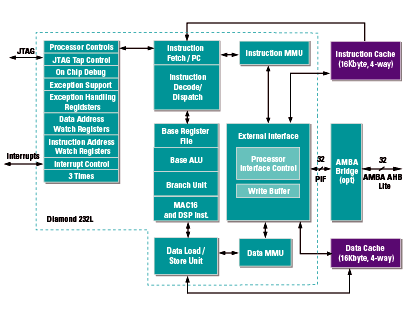“Post-RISC-style” processor targets mobile Linux devices
Mar 3, 2006 — by LinuxDevices Staff — from the LinuxDevices Archive — 1 viewsTensilica announced six new processor cores last week, including one aimed specifically at mobile devices based on Linux. The Diamond Standard 232L is positioned as “the lowest-power processor capable of running the Linux operating system,” and is claimed to have better performance than ARM's successful ARM926EJ-S core design.
Tensilica's processor cores are based on its “Xtensa” instructure set, described as a “post-RISC-style” architecture that supports 32-, 24-, and 16-bit instructions, with modeless switching. Using shorter instructions when feasible reduces power consumption and increases code density, the company says — similar to the way ARM markets its 16-bit “Thumb” and Thumb-2 instructions. Xtensa also features “register windows,” said to enable efficient procedure switches.
Tensilica says it designed the Diamond Standard 232L specifically to run Linux, with an MMU (memory management unit) and 16KB each of four-way associative instruction and data cache. The company worked with MontaVista to create a version of Linux Professional Edition optimized for the processor, it says.

Tensilica Diamond Standard 232L architecture diagram
In addition to basic Xtensa instructions, the Diamond Standard 232L supports an array of DSP instructions, useful in control and signal processing applications, according to Tensilica. Supported DSP instructions include MAC15, MUL15, min/max, sign extend, and NSA (normalized shift amount) instructions.
Tensilica compares its Diamond Standard 232L favorably to ARM's ARM926EJ-S, a core that powers such high-profile mobile SoCs as Freescale's i.MX and TI's Davinci. The 232L consumes less power, offers more MIPS per MHz, and is less than half the size, making it less expensive to fabricate, according to Tensilica.
| ARM 926EJ-S | Diamond 232L | |
|---|---|---|
| Max Frequency (0.13u G) worst case, optimized for speed |
250 MHz | 200-233 MHz |
| Dhrystone MIPS | 275 | 300 |
| Area | 1.68 mm-2 | 0.80 mm-2 |
| mW per MHz (0.13u G) typical conditions | 0.30 | 0.212 |
| Zero-overhead looping | No | Yes |
| # Interrupts | 3 | 15 |
| Timers | No | Yes |
Tensilica's VP of marketing, Steve Roddy, stated, “Linux has quickly become one of the most popular operating systems for embedded applications. With our Diamond Standard 232L processor core, we enable designers to develop new systems with significantly reduced power requirements — essential for handheld mobile applications.”
Availability
Tensilica's new Diamond Standard family of processors is available now either direct from Tensilica, or from ASIC and foundry partners. Tensilica has not revealed which if any semiconductor vendors have committed to using the Diamond 232L. However, its published 40-company customer list for all processor cores is a veritable who's who of consumer electronics chipmakers.
In addition to the 232L, other processors in the newly available Diamond line include:
- 108Mini — an ultra-low power, cost-optimized cacheless RISC controller with rich interrupt architecture and minimal gate count
- 212GP — a mid-range RISC controller with instruction/data caches and user selectable local memory sizes, said to offer 50 percent better DMIPS performance and 30 percent lower power than ARM9
- 570T — a high-performance 3-issue static superscalar CPU core said to offer two times better EEMBC benchmark performance than ARM11-based systems
- 330HiFi — a low power 24-bit audio processor for popular audio and speech codecs
- 545CK — positioned as “the highest performance licensable DSP on the market,” with a VLIW processor and 8-MAC (Multiply ACcumulator), SIMD (Single Instruction, Multiple Data) DSP
This article was originally published on LinuxDevices.com and has been donated to the open source community by QuinStreet Inc. Please visit LinuxToday.com for up-to-date news and articles about Linux and open source.